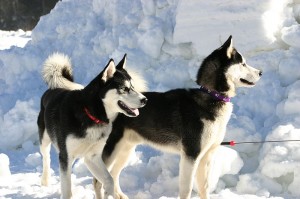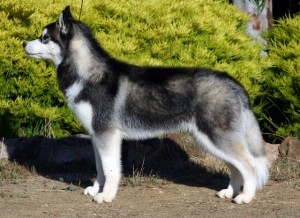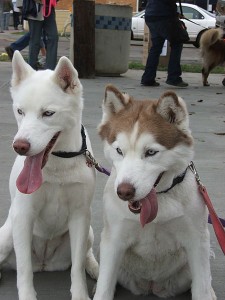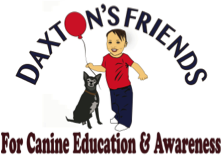The term ‘husky’ refers to a variety of northern sled-pulling dogs, including Malamutes, Siberian Huskies, Alaskan Huskies, and the Samoyed. The variants that were used for Inuit hunting and pulling freight are larger, the ones used for races like the Iditarod are somewhat smaller. The racing Alaskan huskies are in fact mutts, a mix of the fastest sled dogs with the greatest endurance, created by Europeans and not by native northern peoples**.
 Huskies of all kinds are happiest when they are working and exercising. They require daily exercise and activities such as running or swimming. If they do not get enough exercise they tend to become highly destructive – or they turn into escape artists. They do best in homes that have fenced yards for them to play in, though it remains important to give them enough exercise and mental diversion because it’s difficult to design a fence that can contain them if they get bored. They are considered the Houdinis of the dog world, loving to roam and easily climbing fences or escaping their kennels. Many Huskies enjoy recreational dog sledding or jogging to burn off extra energy.
Huskies of all kinds are happiest when they are working and exercising. They require daily exercise and activities such as running or swimming. If they do not get enough exercise they tend to become highly destructive – or they turn into escape artists. They do best in homes that have fenced yards for them to play in, though it remains important to give them enough exercise and mental diversion because it’s difficult to design a fence that can contain them if they get bored. They are considered the Houdinis of the dog world, loving to roam and easily climbing fences or escaping their kennels. Many Huskies enjoy recreational dog sledding or jogging to burn off extra energy.
Huskies have little respect for the yard and love to engage in activities, such as digging. They can damage yards quickly and it may be hard to maintain grass or flowers beds when they are around.
Huskies are highly intelligent dogs and can do practically anything they put their mind to. Huskies have a strong “prey drive” and are generally are not recommended for families with small animals. They are skilled, patient hunters and are notorious for ending the lives of other house hold animals. Huskies can do well with older children if well socialized and trained to know that children are friends and mean good things happen. No matter how well socialized a Husky is, it remains dangerous around infants and toddlers in particular, seeming to perceive them as small non-human animals. Extreme caution should be taken with all interactions with children.
They are hardy canines that are able to withstand harsh, cold climates due to their inherited tremendous stamina and warm coat. Their lightweight build enables them to be quite agile and move with great speed. Huskies are not well suited for the heat and owners must be careful not to let them overheat in warmer temperatures. In sled racing country, races are cancelled if the temperature is above 15C / 59F**.
Huskies will easily make friends with most humans and fellow canines. Huskies are happier when they have a companion of similar size to play with. They can be affectionate, but it has to be on their own terms. They are considered, strong willed, aloof, and independent. Huskies are considered ineffective guard dogs and have little interest in being guardians.
Huskies have a tendency to howl, but they rarely bark. They will howl with each other, to “talk” to you, or just for fun. Once a Husky starts to howl, it may be difficult to get them to stop and they may talk for several minutes. This can make them difficult to own in community living situations where neighbors may not appreciate the noise.
 Huskies weigh in at anything from 45-100 pounds, depending on what type you are looking at. They are all high shedders and need regular brushing. They shed seasonally at least twice per year. The Husky is prone genetic diseases such as hip dysplasia, some eye issues, PRA, corneal dystrophy, and crystalline corneal opacities. Their life expectancy is between 12 and 15 years.
Huskies weigh in at anything from 45-100 pounds, depending on what type you are looking at. They are all high shedders and need regular brushing. They shed seasonally at least twice per year. The Husky is prone genetic diseases such as hip dysplasia, some eye issues, PRA, corneal dystrophy, and crystalline corneal opacities. Their life expectancy is between 12 and 15 years.
** Coppinger and Coppinger (2001), Dogs; A Startling New Understanding of Canine Origin, Behavior & Evolution, Scribner, 1230 Avenue of the Americas, New York NY 10020, Chapter 5, pages 157 – 187.
